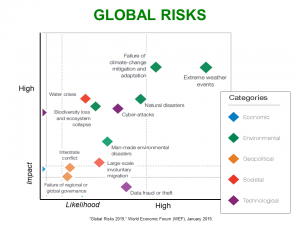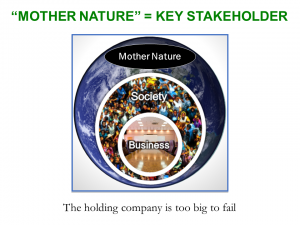5 Reasons Why “Mother Nature” is a Key Stakeholder
For years, companies have treated the environment as an externality. The environment is not on their radar screens of stakeholders to whom they need to pay attention. Stakeholders are defined as “anybody who can affect, or is affected by, an organisation, strategy or project.” The environment is not a body / person. Maybe calling it “Mother Nature” would personify it enough for it to qualify as an “anybody.” There are five reasons why it’s time to treat Mother Nature as a key stakeholder.
Mother Nature is our holding company
The nested-interdependencies model of sustainability, reflects their interdependent reality. It shows that society and the economy are wholly-owned subsidiaries of the environment. The environment is our holding company. If it goes out of business, we all go out of business.
Holding companies qualify as key stakeholders. If we personify the environment / natural capital / ecosystem services as “Mother Nature,” Mother Nature is every company’s ultimate holding company. Therefore, Mother Nature is a key stakeholder for every business. QED.
Mother Nature is too big to fail.
Mother Nature is not only a holding company, she is a big holding company. She provides us with provisioning services such as minerals, food, water, timber, and fiber; regulating services that affect climate, floods, disease, wastes, and water quality; cultural services that provide recreational, aesthetic, and spiritual benefits; and supporting services such as soil formation, photosynthesis, and nutrient cycling.
In 1997, ecologist Robert Costanza and a team of researchers famously assessed the value of these “free” ecosystem services provided by Mother Nature at $33 trillion / year in 1995. That’s how much we would have to pay to recreate those services if for some reason they didn’t occur naturally. Of course, his methodology  and assumptions were immediately criticized for overvaluing, undervaluing and even presuming to monetize the value of invaluable services. So, in 2014, he and his colleagues redid his study and discovered that some of his critics were right. He had undervalued ecosystem services: they were worth $145 trillion / year in 2011. For comparison, global GDP was $75.2 trillion in 2011, roughly half the value of ecosystem services provided that year.
and assumptions were immediately criticized for overvaluing, undervaluing and even presuming to monetize the value of invaluable services. So, in 2014, he and his colleagues redid his study and discovered that some of his critics were right. He had undervalued ecosystem services: they were worth $145 trillion / year in 2011. For comparison, global GDP was $75.2 trillion in 2011, roughly half the value of ecosystem services provided that year.
Mother Nature’s higher value in 2011 was because of improved evaluation methodologies, not because of improved ecosystem services. In fact, the exhaustive Millennium Ecosystem Assessment determined that “60% of ecosystem services examined are being degraded or used unsustainably, including fresh water, capture fisheries, air and water purification, and the regulation of regional and local climate, natural hazards, and pests.” Costanza’s study estimated the loss of eco-services from 1997 to 2011 at $4.3–20.2 trillion / year.
Mother Nature is too big to fail … but she is failing. Her free ecosystem services have been vastly undervalued, taken for granted and abused by business. Why? Because she has not been treated with the attention, respect and care paid to a key stakeholder, especially a big holding company. It’s time to correct that oversight.
Mother Nature’s demise is threatening business
The World Economic Forum (WEF) produces an annual Global Risks report of threats to the wellbeing of economies / businesses within the next ten years. One of the five categories of risks is environmental risks – the five green ones in the close-up of the high impact / high likelihood quadrant in the figure from this year’s report. The environmental risks map well to the four categories of ecosystem services provided by Mother Nature.
- Provisioning services: Water crisis – it is classified as a social risk in the WEF report, but its root cause is environmental
- Regulating services: Failure of climate-change mitigation and adaptation; Extreme weather events
- Supporting services: Biodiversity loss and ecosystem collapse
- Cultural services: Natural disasters and man-made environmental disasters that threaten spiritually, historically and recreationally significant sites
Mother Nature’s failing ecosystem services can directly or indirectly impact / affect companies and companies can impact / affect Mother Nature’s ecosystem services. She fits the definition of a key stakeholder – perhaps a company’s most important one. Case closed.
Mother Nature’s surrogates are too easily marginalized
Historically, businesses have sometimes included environmental non-governmental organizations (ENGOs) in their stakeholder mix. Examples of ENGOs are the World Wildlife Federation (WWF), the Nature Conservancy, the David Suzuki Foundation, the Environmental Defense and Greenpeace. They do excellent work and act as Mother Nature’s voice on critical environmental issues.
However, when a company includes ENGOs in its stakeholder analyses, it usually assesses the impact that the ENGO might have in the company, not the impact of damaged ecosystem services that ENGOs represent. If the ENGOs are weak or non-existent in the company’s jurisdiction, there is a danger that companies could overlook impacts that destabilized ecosystem services, like climate regulation, could directly or indirectly have on its value chain. She needs to represent herself.
There’s no downside
Let suppose a company gave Mother Nature a seat at its stakeholders table. Often there are individuals representing customers, suppliers, investors and other stakeholders in stakeholder roundtable consultations, so having someone represent Mother Nature would not be a big stretch.
Whoever is tasked to represent Mother Nature could use ecosystem services to frame their point of view. They could start with the five environmental risks to businesses described in the above WEF Global Risks 2019 report and then explore other provisioning, regulating, supporting and cultural ecosystem services that might be material to the company. Then the company can decide which ecosystem services should be included on the company’s stakeholder map, either individually or collectively as “Mother Nature.”
What’s the worst thing that could happen? Nothing that shouldn’t happen anyway as part of the normal enterprise risk management (ERM) and scenario planning processes. Treating Mother Nature as a stakeholder legitimizes environmental risks within these processes. In the 20th century, it wasn’t a big deal if they weren’t included. In the 21st century, it is. The cumulative effect of the damage we have wrought on ecosystems services is boomeranging back onto businesses. The Task Force on Climate-related Financial Disclosures (TCFD) recommends that corporations disclose their processes for managing climate-related risks. Climate regulation is just one of the Mother Nature’s destabilized ecosystem services in the 21st century. It’s time to update ERM and scenario planning processes with environmental risks and factors. Treating Mother Nature as a key stakeholder ensures that happens.
Companies pride themselves on stakeholder engagement and stakeholder management. Companies pay special attention to key stakeholders. They certainly don’t want to cause them harm and usually want to affect them positively. So, for the sake of both the business and the environment, I move that Mother Nature be treated as a key stakeholder by all companies. Is there a seconder?
Stay tuned for reasons why “Future Generations” should join “Mother Nature” at the key stakeholders’ table …
Please feel free to add your comments and questions using the “Leave a reply” comment box under the “Share this entry” social media symbols, below. For email subscribers, please click here to visit my site and provide feedback. Slides shown will be included in my next quarterly release of Master Slide Decks, to which anyone can subscribe.





Comments are closed.